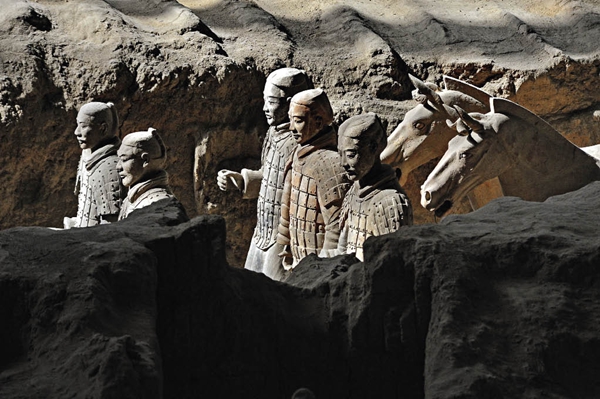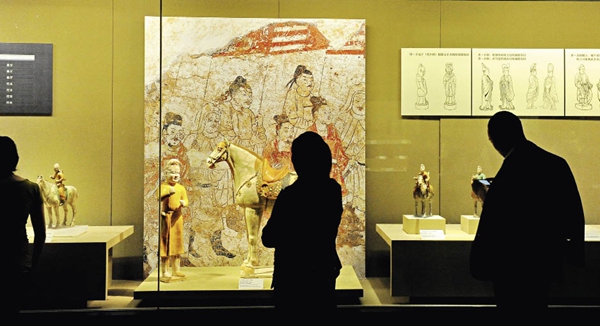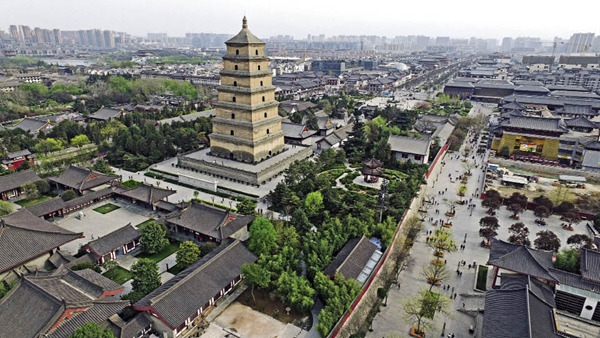Charismatic, Enigmatic, Romantic Xi’an
Xi’an’s History
The city ruins unearthed at Yangguanzhai Village, Gaoling County in Xi’an are the oldest ever discovered in China, and imply that Xi’an’s history dates back 6,000 years to the later Neolithic period.
In the 11th century BC, as the State of Zhou steadily grew, it founded two boroughs – Fengjing, the religious and cultural center, and Haojing, the seat of governance, together known as Fenghao. These two cities both lay amidst today’s Xi’an, and were seminal in the initial construction of Xi’an as a city. After Zhou annexed Shang and established a new dynasty, it proclaimed Fenghao as its capital, an event that marked the founding of Xi’an as a capital city in multiple regimes through history. Over the ensuing millennia, Xi’an has been a political, economic and cultural center in China with a unique historical status.

SITUATED in the central Guanzhong Plain, Xi’an City, called Chang’an in ancient times, is today the provincial capital of Shaanxi Province.
At the forefront of famous Chinese historical and cultural cities, Xi’an boasts six sites that have won UNESCO World Heritage Site listing – the Mausoleum of the First Qin Emperor and the Terracotta Warriors, the Big Wild Goose Pagoda, the Little Wild Goose Pagoda, the Da- ming and Weiyang Palaces of the Tang and Han dynasties respectively, and the Pagoda of the Xingjiao Temple.
A cradle of Chinese history and culture, Xi’an and its environs witnessed the earliest emergence of Chinese civilization. It served as China’s capital and political, economic and cultural center for over 1,100 years, and thus reflects the full panoply of Chinese history in microcosm. A trip to Xi’an brings visitors to close contact with China’s long history and rich culture.
The third century BC saw the founding of the Qin Dynasty, the first unified, multi-ethnic and centralized state, with its capital of Xianyang, now a prefecture-level city adjacent to Xi’an. The main part of Epang Palace, the palace complex of the first emperor of the Qin Dynasty, is in today’s Xi’an City. According to archaeological findings, Epang Palace assumes a grand scale: it covers an area of about 15 square kilometers, which compares favorably with the Forbidden City in Beijing, which covers a mere 0.72 square kilometers. Although it was said that more than 100,000 laborers worked on construction of the Epang Palace each day, it had not been completed by the time the Qin Dynasty fell.
In 202 BC, Liu Bang rose to power and established the Han Dynasty. He situated his capital in Chang’an (today’s Xi’an), a name which means “perpetual peace” in Chinese. He renovated the Xingle and Zhangtai Palaces of the Qin Dynasty and renamed them the Changle and Weiyang Palaces respectively. Chang’an City covered an area of around 36 square kilometers. During the Western Han Dynasty (206 BC-AD 24), it served as the political, economic and cultural center of the country. It was the first city in China’s history to feature a large scale and a mass population. The palaces constructed during the Han all lie in a protected zone in Xi’an today. The mausoleums of Emperor Wendi, Emperor Wudi and Emperor Jingdi of the Han Dynasty lie in today’s Xianyang City. After the Silk Road was established, the termini of the road were said to be Rome in the West and Chang’an in the East.
In 581 Yang Jian founded the Sui Dynasty (581-618) and set the capital in Chang’an. However, Chang’an had become ruined by years of warfare. Therefore, Yang decided to build a new capital; this eventually became Daxing to the southeast of the Han Dynasty site of Chang’an.

The Tang Dynasty Chang’an exhibition at the Shaanxi History Museum.
Yu Xiangjun
After the founding of the Tang Dynasty (618-907), Daxing was renamed Chang’an and further expanded. In 634, Daming Palace was built to the northeast of the original outer city wall. In the following years, new city walls, gate towers, and Xingqing Palace were all erected. By 654, Chang’an City had expanded to 84.1 square kilometers and appeared in a strictly symmetrical format. It was divided into three parts: namely the Palace City, the Imperial City and the Outer City. The Palace City covered exactly same area as today’s Xi’an City. China enjoyed great prosperity during the Tang Dynasty. Chang’an City of this period was the most magnificent and grand capital in China during its entire feudal period. It has had an epoch-making influence on China’s history of architecture and urbanization.
In the 10th century, feudalism started to wane in China. The country’s center gradually shifted from the western to the central and eastern regions. In 1369, the name “Xi’an” was adopted by the Ming Dynasty, and has been used ever since.
Home to Many Emperors
Throughout its history, 13 dynasties have based their capitals in Xi’an, the clear reason why the city revels in rich culture and relics of many palaces and mausoleums. People today delight in rehashing the stories and anecdotes about the emperors and their imperial kin who used to live on this land.
Qin Shi Huang (259-210 BC), or the First Qin Emperor, was the first emperor of China. He succeeded his father to become the king of Qin when he was 13 years old, but had established the first centralized, unified, multi-ethnic state in Chinese history by age 39. He unified the written language, currency and weights and measures. He established a polity wherein the emperor exercised supreme power and this institution was retained in China for the ensuing 2,000 years. He called himself the First Emperor of Qin and stipulated that his successors must continue to use the title as Emperor Qin II, Emperor Qin III and Emperor Qin Forever.
During his reign, Qin Shi Huang decreed that the defense works of former states must interconnect into a single wall to consolidate the regime’s frontier defenses, an act that marked the genesis of the Great Wall of China. The Great Wall of Qin started in Minxian County in Gansu Province in the west and extended eastward through today’s Ningxia Hui Autonomous Region, Shaanxi Province, Inner Mongolia Autonomous Region, Hebei Province and Liaoning Province to end at the estuary of the Chongchon River to the northwest of today’s Pyongyang, North Korea. The Great Wall is considered one of the seven architectural wonders of the world.
Wu Zetian (624-705) was China’s only empress. Born into a noble family, she was selected at age 14 as a concubine of Emperor Taizong of Tang. After Taizong’s death, she married his successor – Emperor Gaozong – and became his empress. She helped Gaozong and later their two sons deal with state affairs for 30 years, and ultimately crowned herself at age 67. She governed the country, both unofficially and officially, for nearly half a century.
In consideration of the traditional Chinese society where women were deemed inferior to men, Wu Zetian has garnered both praise and criticism from posterity. Few written materials survive about her 12 years’ service as Taizong’s concubine, and we even lack a record of her given name. It is however indisputable that she was exceptionally gifted and able to grasp opportunities. Emperor Gaozong greatly loved and supported her. They shared similar views on politics, so Gaozong stipulated in his will that his empress had the final say on major state affairs after his death.

The Big Wild Goose Pagoda.
After Wu Zetian died, she and Gaozong were interred together in Qianling Mausoleum, in front of which stand two stelae – one for the husband which bears an inscription by Wu Zetian and another one for the wife, but devoid of any characters. Why the tablet is wordless remains an enigma to this day, although evidence suggests the stele was left blank at Wu Zetian’s request.
In 712, the seventh year after Wu’s death, Emperor Xuanzong (685-762) of Tang acceded to the throne, and inaugurated the Kaiyuan Era, during which feudal China rose to its pinnacle of culture and power. At that time, the capital city Chang’an became an international metropolis and entrepôt for various exchanges. Its architectural style exerted a great influence on the planning and construction of capitals not only in China in the following dynasties, but also in Korea and Japan. Heijo-ky and Heian-ky in Japan were both modeled after Chang’an.
A retrospective of the story of Emperor Xuanzong should not overlook his beloved consort Yang Yuhuan (719-756). Generations of poets and men of letters have created many classical pieces based on their love story. For example, Bai Juyi, a famous Tang poet, recounts their love in his Song of Everlasting Sorrow.
However, the outbreak of the An Lushan rebellion drove Xuanzong and Yang to flee to Maweipo, about 50 kilometers north of present-day Xi’an. Forced by outraged soldiers, Li had no choice but to order the execution of Yang, bringing their love story to a tragic end. She was a precursor to Marie Antoinette: Li lavished so much of his time on Yang in endless enjoyment that he neglected state affairs and the Tang fell into decline. However, their true and sincere love has moved many people, and remained an evergreen topic of conversation among succeeding generations.



